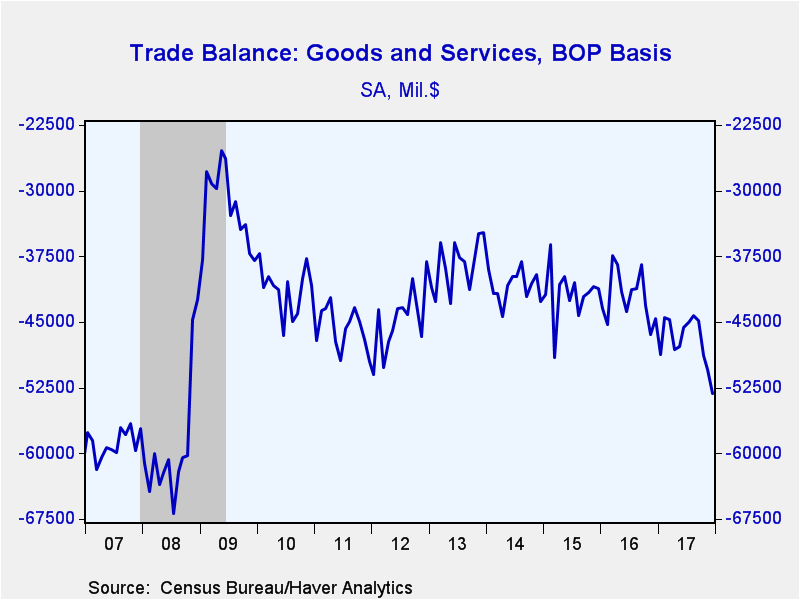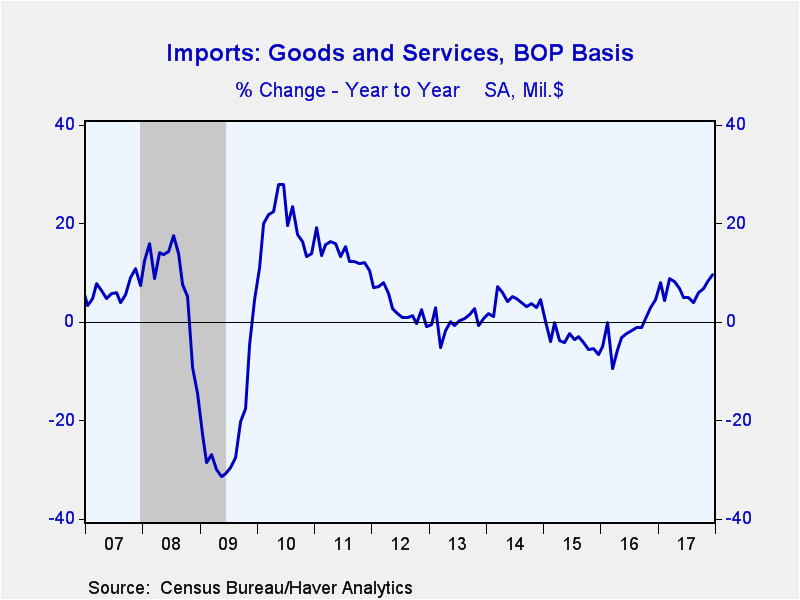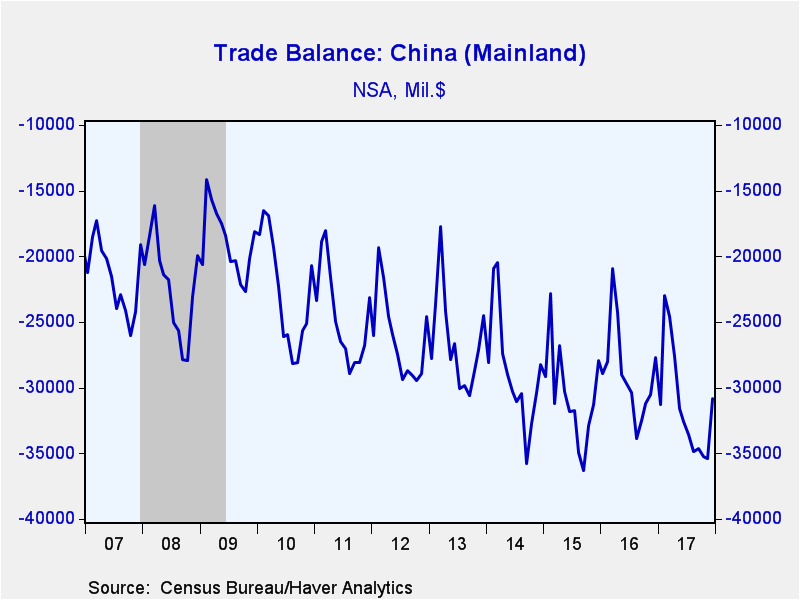 Global| Feb 06 2018
Global| Feb 06 2018U.S. Trade Deficit Increases As Import Growth Outstrips Exports
by:Tom Moeller
|in:Economy in Brief
Summary
The U.S. trade deficit in goods and services increased to $53.1 billion in December from $50.4 billion in November, revised from $50.5 billion. A $52.0 billion deficit had been expected in the Action Economics Forecast Survey. Exports [...]
The U.S. trade deficit in goods and services increased to $53.1 billion in December from $50.4 billion in November, revised from $50.5 billion. A $52.0 billion deficit had been expected in the Action Economics Forecast Survey. Exports increased 1.8% (7.3% y/y) following a 2.3% rise while imports gained 2.5% (9.5% y/y) for the second consecutive month. During all of last year, the trade deficit rose to $566.0 billion, its deepest level since 2008. Exports increased 5.5%, the largest gain since 2012 while imports rose 6.7%, the largest rise also since 2012.
The deficit on goods trade rose to $73.3 billion in December, its deepest since July 2008. Exports of goods rose 2.5% (8.8% y/y) following a 3.4% rise. It reflected a 4.3% increase (0.3% y/y) in foods, feeds and beverages exports following a 1.4% rise. Exports of industrial supplies & materials increased 3.7% (19.8% y/y) after a 0.8% gain. Nonauto capital goods exports rose 2.5% (5.3% y/y) after a 5.7% jump. Auto exports eased 0.6% (+9.1% y/y) following a 7.7% strengthening, and exports of nonauto consumer goods declined 1 .2% (+1.9% y/y) after a 4.0% rise.
Imports of goods rose 2.9% (10.3 y/y) following a 3.0 gain. It was driven by a 6.1% jump (12.1% y/y) in nonauto consumer goods imports that followed a 4.8% rise. Auto imports increased 3.5% (1.7% y/y) following a 1.2% rise. Capital goods imports gained 1.5% (13.6% y/y) after a 2.9% rise, and foods, feeds & beverage imports rose 2.1% following a 1.0% decline. Imports of industrial supplies & materials rose 1.3% (12.5% y/y) after a 1.3% rise.
Petroleum imports declined 6.3% (+14.2% y/y) after a 10.1% jump. Non-petroleum imports increased 3.7% (10.1% y/y) following a 2.4% rise. The value of energy-related imports fell 7.0% (+13.8% y/y) as the per barrel cost of crude oil rose to $52.10 (25.8% y/y), the highest level since July 2015. The quantity of energy-related imports declined 10.1% (-9.1% y/y) following a 1.2% rise.
The surplus on services trade held steady both m/m and y/y at $20.3 billion. Services exports improved 0.2% (4.3% y/y) for a second straight month. Charges for intellectual property rights nudged 0.1% higher (2.9% y/y) after a 0.2% gain. Transport charges declined 0.9% (+0.5% y/y) for a second straight month, and travel exports increased 0.6% (-0.5% y/y). Imports of services jumped 2.5% (9.5% y/y) for a second consecutive month. Charges for intellectual property rights rose 1.2% (13.5% y/y), also for a second month. Transport charges eased 0.2% (+2.9% y/y) and travel imports strengthened 1.8% (10.9% y/y).
By country, the goods trade deficit with China narrowed m/m to $30.8 billion (NSA), and amounted to $375.2 billion for the full year versus $347.0 billion in 2016. The trade deficit with the European Union widened m/m to $15.8 billion (NSA) in December, and increased to $151.4 billion for the year from $146.8 billion in 2016. The trade deficit with Japan eased m/m to $5.5 billion, and totaled $68.8 billion for the year, the same as in 2016.
The international trade data can be found in Haver's USECON database. Detailed figures are available in the USINT database. The expectations figures are from the Action Economics Forecast Survey, which is carried in AS1REPNA.
| Foreign Trade in Goods & Services (Current Dollars) | Dec | Nov | Oct | Y/Y | 2017 | 2016 | 2015 |
|---|---|---|---|---|---|---|---|
| U.S. Trade Deficit | $53.1 bil. | $50.4 bil. | $48.9 bil. | $44.6 bil. (12/16) |
$566.0 bil. | $504.8 bil. | $500.4 bil. |
| Exports of Goods & Services (% Chg) | 1.8 | 2.3 | -0.1 | 7.3 | 5.5 | -2.5 | -4.7 |
| Imports of Goods & Services (% Chg) | 2.5 | 2.5 | 1.6 | 9.5 | 6.7 | -1.9 | -3.6 |
| Petroleum (% Chg) | -6.3 | 10.1 | 8.6 | 14.2 | 27.0 | -19.4 | -45.5 |
| Nonpetroleum Goods (% Chg) | 3.7 | 2.4 | 1.3 | 10.1 | 5.7 | -1.2 | 2.2 |
Tom Moeller
AuthorMore in Author Profile »Prior to joining Haver Analytics in 2000, Mr. Moeller worked as the Economist at Chancellor Capital Management from 1985 to 1999. There, he developed comprehensive economic forecasts and interpreted economic data for equity and fixed income portfolio managers. Also at Chancellor, Mr. Moeller worked as an equity analyst and was responsible for researching and rating companies in the economically sensitive automobile and housing industries for investment in Chancellor’s equity portfolio. Prior to joining Chancellor, Mr. Moeller was an Economist at Citibank from 1979 to 1984. He also analyzed pricing behavior in the metals industry for the Council on Wage and Price Stability in Washington, D.C. In 1999, Mr. Moeller received the award for most accurate forecast from the Forecasters' Club of New York. From 1990 to 1992 he was President of the New York Association for Business Economists. Mr. Moeller earned an M.B.A. in Finance from Fordham University, where he graduated in 1987. He holds a Bachelor of Arts in Economics from George Washington University.










